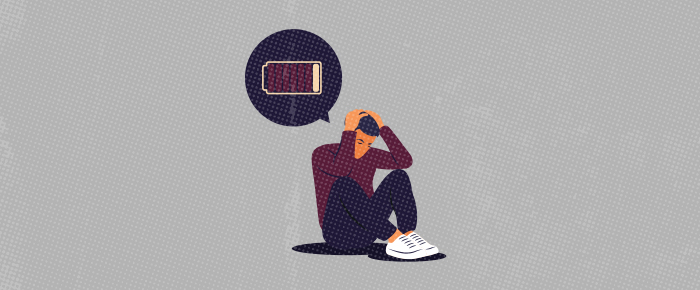
Burnout is not new to the early post-pandemic era. It has been a common corporate buzzword since the first days of the cubicle. In 2020, burnout became widespread as remote work sparked a mental health awareness revolution.
In 2020, the number of people working remotely increased from 4.7 million to approximately 75 million.1 Obviously, remote work did not cause the rate of burnout to increase. Working from home (WFH) helped many peoples’ careers, personal wellbeing and productivity. However, the pandemic, death on a massive scale, the inability to move about freely, and separation from family and friends all caused unprecedented stress. Add to that mass unemployment, a recession, lack of childcare and in-school teaching, increased workloads, and you had mental health specialists and human resources (HR) professionals shouting from the rooftops. To illustrate the effects of the pandemic in March 2020, when WFH became the way of life, “78 percent of all anti-depressant, anti-anxiety, and anti-insomnia prescriptions filled were new (versus refills).”2
On average, the workday became 48.5 minutes longer following the lockdowns in March 2020.3 No commutes and no physical distinction between our work and personal space has made it easy—if not natural—to overwork. The U.S. Census Bureau reported that 42% of people surveyed had symptoms of anxiety and depression in December 2020. That number was 11% in 2019.4 The pandemic is still not over, and the effects will linger for a long time. Burnout is an increased threat to our jobs and careers. This article will discuss how to spot burnout, prevent it and deal with it when it sneaks up on us.
What Is Burnout?
There are differing opinions about what constitutes burnout, and it is not completely accepted as a mental disorder.5 The term “burnout” gained its modern definition from a psychologist, Herbert Freudenberger, in 1974, who was observing workers in a high-stress environment at a free clinic in New York City.6 Over the last 10 years, a succinct, if not scientific, summary of burnout has evolved. The Mayo Clinic defines burnout as a “state of physical and emotional exhaustion that also involves a sense of reduced accomplishment and a loss of personal identity.”7 Burnout is more than exhaustion; it is the product of long-term stress that has not been addressed. The most common characteristics of burnout are fatigue, agitation and impatience with others, a feeling of no control and pointlessness at work and home, and general apathy and pessimism toward life.
In his research, Freudenberger created a “Burnout Phase Model” to describe the “chronological development” of burnout, which looks like the following:8
- Compulsion to prove oneself (excessive ambition)
- Working harder
- Neglecting one’s own needs
- Displacement of conflicts and needs
- No time for nonwork-related needs
- Increasing denial of the problem, decreasing flexibility of thought/behavior
- Withdrawal, lack of direction, cynicism
- Behavioral changes/psychological reactions
- Depersonalization: Loss of contact with self and one’s own needs
- Inner emptiness, anxiety, addictive behavior
- Increasing feeling of meaninglessness and lack of interest
- Physical exhaustion that can be life-threatening
Burnout tends to start with good intentions: You want to succeed, crush a task and be acknowledged for it (step 1). But those good intentions lead to working harder and harder (step 2), limiting the time needed to exercise, eat healthy and diligently, and sleep (step 3). The lack of self-care understandably leads to irritability, resentment and less production at work. Who do you blame? Not yourself. Your problems have to do with the job itself, your inept colleagues and your demanding boss (step 4).
Your overwhelming stress causes you to evade socializing either because you do not have the time or want to be around friends, family and loved ones. Not only does socializing take a back seat, you also consider it a burden (step 5). This is where the vicious cycle starts and causes a feedback loop. Your bad moods, agitation and tension cause you to not only blame others but also lead to denial (step 6). Your bad state is others’ fault and has nothing to do with your behavior. At this point, you are beyond just rejecting invitations to hang out. You are now finding ways to stay away from everyone who brought you joy in life (step 7). Being over-stressed, resentful, and lacking any outlet for your emotions and anxiety causes you to treat everyone around you poorly, with little patience, and, possibly, with physical and emotional aggression (step 8). At this point, you are unrecognizable to people who know you best. Steps 8 through 12 are considered the point at which a person burns out and then enters habitual burnout.9
This is where depersonalization, exhaustion and depression meet to create a feeling of powerlessness (step 9). It is a bad place to be because it takes a lot of effort and time to heal from the condition you are in at this point. Many people develop an addiction to drugs, alcohol, gambling or other detrimental activities that provide only the shortest relief and enjoyment (step 10). You have reached the point where the continuing stress leads to situational depression. You are asking yourself, what is the point (step 11)? And no one ever believes they are the type of person to let themselves get to step 12.
Recognizing Burnout
Spotting burnout in yourself before reaching step 5 involves self-awareness. We cannot always depend on others to be wary enough to know when we are not ourselves. Burnout manifests itself physically, emotionally, and behaviorally. Keep a diligent lookout for these changes in yourself (and others):10
- Physical:
- Constant and consistent exhaustion; feeling tired all the time
- Discomfort, aches and pains; headaches, frequently sick
- Emotional:
- Constant and never-ending pessimism
- Declining sense of accomplishment (while working more)
- Decreasing interest in hobbies, socializing, family and friends
- Behavior:
- Increasing consumption of alcohol; use of illicit drugs and narcotics
- Decreasing patience and shorter temper
- Abnormal outbursts directed toward colleagues, friends and superiors
The path toward burnout is rifled with self-sabotage and poor decision-making that feeds into a debilitating feedback loop. However, only by recognizing the signs of burning out can you prevent full-blown burnout.
Tips for Preventing Burnout
The irony is that if you embrace burnout’s existence, you have won half the battle. The other half of the battle is paying respect by preventing its onset after acknowledging it. It just so happens that the regimen for preventing burnout is similar to living an active, healthy lifestyle. Not surprisingly, respecting burnout involves combining mindfulness with physical wellbeing. The following are some tips:11
- Awareness: We are neither our mind nor our body. Let us say we are a separate entity, which keeps tabs on our thoughts, emotions, aches and pains. We must be diligent when we start experiencing steps 3 (neglect) and 4 (displacement). Early recognition is the most important weapon in combating burnout.
- Ask why: Our mind and body are always giving us, the separate entity, status reports every minute of every day. Do I feel happy, thirsty, tired, energetic and so on? However, we need to ask ourselves why we are feeling the way we do. Start asking yourself why your mind is putting out negative thoughts, and your body is leaning toward the television and not the Peloton.
- Be selfish: Do what you need to do, personally, to press the reset button, and I do not mean only when you are sensing things at work going sideways. Find time to exercise every week, work on your new or favorite hobby, host a dinner, write the first paragraph of an ACAMS Today article or start that novel that you have been dying to read. Do whatever allows you to enjoy life and reenergize.
- Realign: Have you ever taken time to write down your values, goals, dreams and aspirations in life? What makes you who you are? After figuring that out, make sure you meditate—literally or figuratively—on your behaviors and what they should be. Is there a disconnect? Is work causing you to do things that your separate entity is questioning? If so, ask the most important question: why? Then figure out how to stop it.
- Think before you eat. This one resonates with me personally. I was at my most fit right when shelter-at-home went into effect in March 2020. Then, I somehow gained 20% of my body weight. I was working too much, moving very little (my step count went down by 75%) and eating whatever gave me comfort. Work did not help my health, and my health did not help my work. I had to be even more diligent with my diet. It was difficult at first, but I started feeling better and felt a sense of control and confidence. Whether it was the renewed confidence or just feeling better, I started to enjoy work, again, much more.
- Do not think before you move: Preventing burnout is pretty much the same as living a healthy lifestyle. Find an exercise regime that you can do regularly and enjoy. You can get a personal trainer or become the wizard of walks. Make sure you get the blood flowing as much as you can.
- Actively sleep: Figure out how much sleep you need. It is difficult with children or tight deadlines at work, but nothing brings you closer to burnout than not getting the right amount of sleep.
- You cannot do it alone: Even introverts need people. Whatever route you take, make sure it involves your trusted advisers, peers, friends, family and colleagues.
Preventing Work-Related Burnout
There are ways to assess whether work-related stress is causing your burnout. Burnout prevention requires self-reflection, personal honesty, deliberate action, regaining control and asking for help.
- Is your stress due to a certain project, deadline or task at work? If so, it is time to plan the work then work the plan. Control, or lack of it, is one of the leading causes of burnout. Regain control of daunting tasks and deadlines by planning the work down to the smallest detail. Make sure to write the plan down. It is very satisfying to cross out items or checkboxes on an action plan. Plus, you can measure how much progress you have made and what you need to do on any given day so you can enjoy any free time you have any way you please.
- Do you have too much on your plate? If you have too much on your plate, delegate. You cannot risk burnout because you are worried about what your colleagues and superiors might think if you ask for help. Bluntly, you should not work at any company that views asking for help as a negative quality.
- Is there a disconnect between your values and the values of your company? There is a theory that there is no such thing as work-life balance. Balance is not the goal—compatibility is. For instance, does your company share the same values, principles and philosophy as you? The only thing more stressful than working hard is working hard for a company you do not like. The opposite could also be true: Working hard for a company you like, respect and have pride in might be more fun than stressful.
- Are you not decompressing enough?12 It is better to take breaks and reenergize before hitting your breaking point, but we do not live in an ideal world. Decompressing is whatever that word means to you. But it involves not doing work for a certain period. Let us say at least one business day. Use your paid time off (PTO). PTO is available for this exact reason, and you are not a more productive or a better worker because you do not use it. You use it so you can do your job 100% when you are on the clock.
The irony is that if you embrace burnout’s existence, you have won half the battle
It is easy to get overwhelmed and overstressed as we take on more and more responsibilities and obligations. Our jobs are, ironically, where we have the most control over potential burnout. We cannot delegate our kids, right? We cannot take a break from our bills or sick relatives. We can find new jobs, ask for time off and ask for help from our colleagues. If life, in general, seems to be pulling you toward exhaustion, maybe your job should be your source of change and relief.
Words of Wisdom—How to Deal With It After It Happens
What do you do when you are burned out? No matter the intrinsic stress of your job (imagine being a healthcare worker in the middle of the pandemic), the weight of the responsibility of taking care of a sick parent or child or a combination of both, you are the only one that can change your circumstances. Presuming you have identified the cause(s) of your burnout, you can really change your life for the better. In addition to the earlier suggestions on how to prevent burnout, consider these ideas:
- You must be the first to forgive yourself: Be nice to yourself when you could have done something better or differently. You can learn from your mistakes without beating yourself up.
- Control what you can and let go of what you cannot: We all want to do everything perfectly, and that is why we are always so hard on ourselves. Make sure to focus on doing your best and then letting go so the universe can work its magic.
- Taking care of yourself is not selfish: Think about the oxygen mask metaphor here. You must put yours on first before helping someone else. Making some “me” time is mandatory for consistent high productivity without burnout.
Although I am working on a weekend, I am not worried about burnout, resentment or poor quality (I have good editors). But I will be on the verge of burnout if I do not lead a deliberately healthy lifestyle. I ask my wife to watch our son when I know I need a good workout. I ask my boss for a random Monday off if I know it will make Tuesday even more productive. And instead of finding comfort in a Twix ice cream bar, I build my confidence in my control by happily eating a banana. I have learned the hard way that I have a strong support network of people that are more than willing to take time to help. Make sure you identify those people in your life, too: a therapist, best friend, parent or grown-up child. You cannot go wrong.
Sanjeev Menon, ACAMS Career Guidance columnist, compliance, legal and privacy senior practice area manager, Infinity Consulting Solutions, Inc., New York, NY, USA, smenon@infinity-cs.com
- Dora Mekouar, “Is Working From Home Here to Stay?” VOA News, April 09, 2021, https://www.voanews.com/usa/all-about-america/working-home-here-stay
- Jeffrey Pfeffer and Leanne Williams, “Mental health in the workplace: The coming revolution,” McKinsey & Company, December 8, 2020, https://www.mckinsey.com/industries/healthcare-systems-and-services/our-insights/mental-health-in-the-workplace-the-coming-revolution
- Roy Maurer, “Remote Employees Are Working Longer Than Before,” SHRM, December 16, 2020, https://www.shrm.org/hr-today/news/hr-news/pages/remote-employees-are-working-longer-than-before.aspx
- Alison Abbott, “COVID’s mental-health toll: how scientists are tracking a surge in depression,” Nature, February 3, 2021, https://www.nature.com/articles/d41586-021-00175-z
- Linda V. Heinemann and Torsten Heinemann, “Burnout Research: Emergence and Scientific Investigation of a Contested Diagnosis,” SAGE, January-March 2017, https://journals.sagepub.com/doi/pdf/10.1177/2158244017697154. Burnout is considered a medical condition only in a few countries.
- Ibid.
- “Job burnout: How to spot it and take action,” Mayo Clinic, June 5, 2020, https://www.mayoclinic.org/healthy-lifestyle/adult-health/in-depth/burnout/art-20046642
- Wolfgang P Kaschka, Dr., Dieter Korczak, Dr. and Karl Broich, Dr., “Burnout: a Fashionable Diagnosis,” Deutsches Arzteblatt Int., https://www.ncbi.nlm.nih.gov/pmc/articles/PMC3230825/
- “What are the 5 stages of burnout?” Calmer, August 20, 2020, https://www.thisiscalmer.com/blog/5-stages-of-burnout
- “Preventing Burnout,” CALE Learning Enhancement Eastern Washington University, https://inside.ewu.edu/calelearning/psychological-skills/preventing-burnout/
- Ibid.
- Jeremy Sutton, Ph.D., “How to Prevent Burnout in the Workplace: 20 Strategies,” Positive Psychology, August 17, 2021, https://positivepsychology.com/burnout-prevention/.










